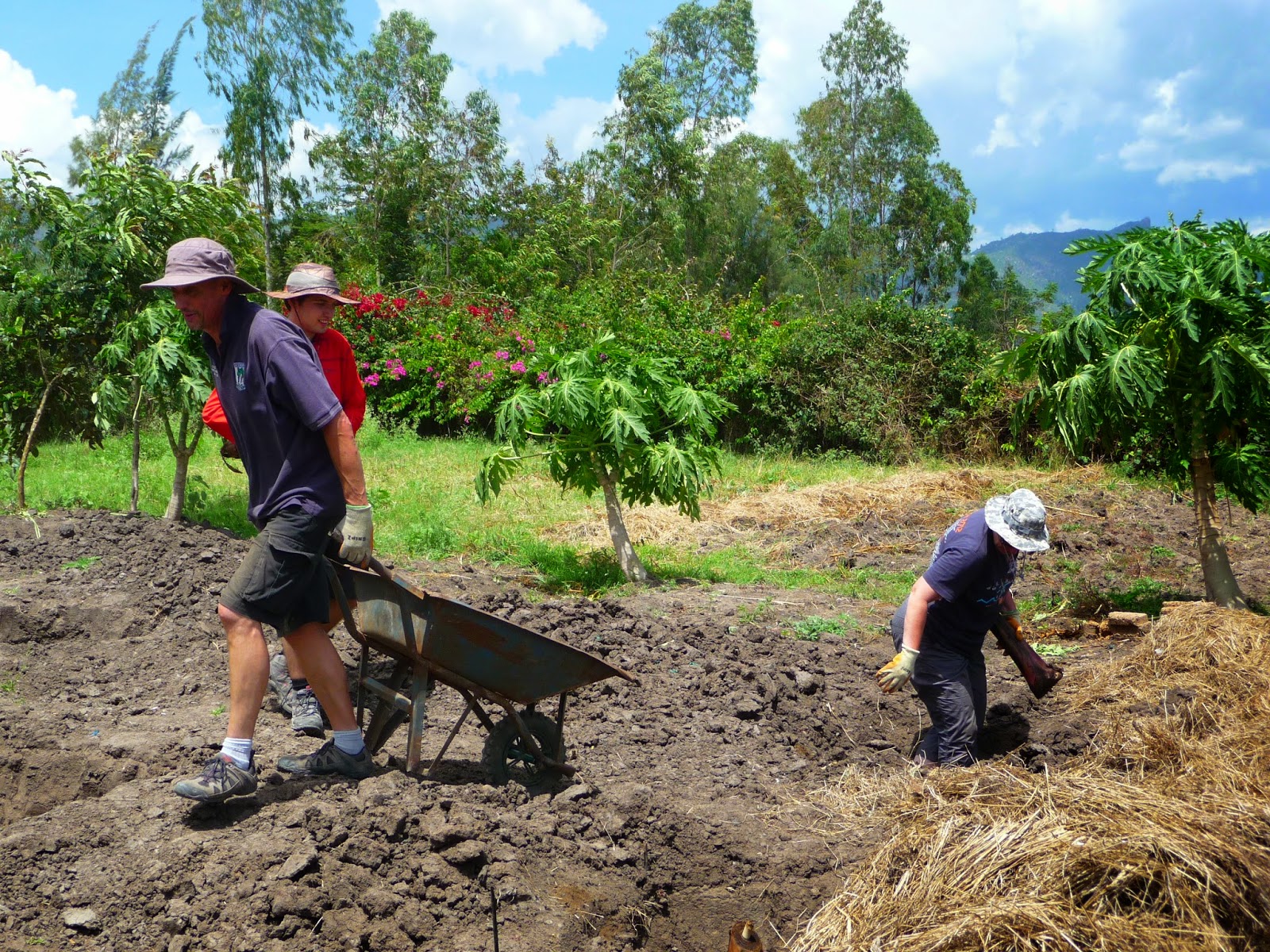“I’m just
going to Kondele to get a door made” said Moses, in the sort of matter of fact
way that these things happen in Kenya, “I will be back in 30 minutes”.
I am not
skilled in the art of door making, but I hazarded a guess that he might be away
a little longer and looked around the land for something that we could be doing.
“We can do
this” said Joseph, pointing at the couple of dozen banana holes we had dug (to
the very prescriptive 3 x 3 x 2.5 described earlier).
“Not more
digging!” we cried, “We have done enough”
“No” he
said smiling, “we can put the bananas into the ground”
Joseph is
the head gardener at Kibos and a man who seems to know a thing or two about
growing things. When we arrived he and Cosmas were busy mixing top soil and
goat manure into a sizeable pile of banana plant friendly fertiliser, a task
that Colin willingly and ably joined in with.
Colin has
been a real workhorse this week, leading his boys brigade group by example,
always looking for the next task that needs to be done.
“Come on
boys” he shouted, “one wheelbarrow full of this in each hole”.
When the
first hole had been filled Joseph unwrapped one of the fresh banana stems from
its warm grassy covering, made a well in the middle of the fertilizer and
buried the base of the stem until it was firmly held.
“What’s
that?” said one of the boys, wondering over to the hole.
“It’s a
banana plant” came the seemingly obvious reply. We had just spent 2 days
digging more than 20 holes the precise dimensions required of the banana, so it
would have taken the nerve of a particularly ambitious cuckoo to claim the
mulched and spacious resting place for a different species.
“It doesn’t
look like a tree?” the boys countered, and it was hard to disagree.
The banana
stems are small, fibrous, unpromising looking things that seem to require the
patience of a saint and the attention to detail of a remarkably fussy
accountant. Once placed into a hole of the right size they will grow to
maturity within 12 months, producing a single stem of between 25 and 30 bunches
of sweet, ripe yellow fruit. The plant is then chopped down and new suckers,
pushed out from its base into the beautifully prepared, soft mulched and
fertilised ground will grow up to take its place. The suckers of the banana can
then be split and planted separately, thus a large, shady and fruitful arbour
can be created within a short time.
We pressed
on, planting stem after stem, until each hole was filled, covered with fresh
topsoil, watered and covered again with straw and grass to prevent the moisture
from evaporating and the ground from drying out.
Two hours
after leaving, for his half hour door, Moses had still not returned.
Thankfully,
we were not idle, as the engineers had arrived to construct the greenhouse from
the selection of metal pieces laid out around the land.
We had had
such fun yesterday, digging holes 6 inches across by 2 foot deep (precisely) in
order to sink the upright supports for the greenhouse (if anyone ever suggests
that you dig 12 holes 2 foot deep, you have my permission to walk the other
way). After a long day of preparation though, the holes had been dug and the
uprights cemented into the ground.
Now, all
our hard work had paid off, as the engineer strode confidently around the plot,
nodding approvingly as he inspected our handiwork and moving the large curved
roof supports into position.
Then he
disappeared.
It
transpired that although he and his colleague had arrived to begin construction
the necessary nuts and bolts that fix everything together had not come with
them (they were on a lorry arriving sometime later from Nairobi).
Working in
Kenya makes you philosophical about timekeeping, but it is fair to say that it
can be frustrating at times**
Moses
appeared shortly after the engineer left, to announce that lunch was served. A
beautiful chicken and peanut stew with rice appeared on the tables and was
hungrily devoured.
As we
savoured the stew and began to pour mugs of steaming tea John came in to say
that the engineer had returned and was looking for helpers. Tea in hand we made
our way back to the land and to the evening task of securing the greenhouse
supports.
“I’m just
off to Kondele” said Moses, “I need to repair a puncture”
“So you
will be two hours?” I replied
“No!”,
Moses laughed, “It will be half an hour”
“Ok”, I
said, “but we will see”
We lifted
and bolted and screwed and riveted until the sky was nearly dark. With each
turn of each nut the greenhouse frame arched ever taller and stronger into the
warm evening sky.
“We have to
stop now”, said the engineer, “it is too dark”
Dusty,
muddy and tired we made our way to the small group of white plastic chairs,
huddled under the compact frame of a gazebo, which had provided much needed
shelter from the mid afternoon sun.
As we
gather our things together Moses drove into the compound.
“It has
been two hours”, I said, a little too triumphantly
“Oh”, said
Moses, “but there was such a long wait at the puncture repair”.
“So are we
ready to go back to the hotel?” I asked, looking around at the tired faces of
the boys brigade,
“Not yet”,
Moses replied, “I just need to change the wheel”.
**Please
see yesterdays blog for a definition of “African Time”





No comments:
Post a Comment